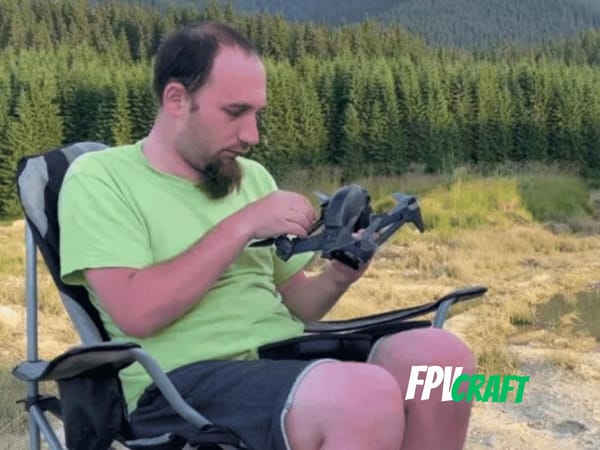Can You Fly FPV Drones in Snowy Weather
We know it's not a good idea to fly an FPV drone in the rain; they're not waterproof. But what about flying in the snowy weather?

An FPV drone is extraordinary for flying in the most severe conditions and unique places, ultimately taking risks. But what about flying an FPV drone in snowy weather? Are you able to?
It is risky to fly an FPV drone in snowy weather as most FPV drones are not waterproof, and in particular, when takeoff or landing, the snow can be blown into the motors or circuit. Flying FPV in snowy weather is even riskier than with a standard drone.
But the information is not limited to the answer paragraph; for this reason, we recommend you keep reading to find out everything about flying an FPV drone in snowy weather.
Flying an FPV drone in snowy weather vs. a standard drone
None of these drones should be flown in snowy weather, wherever it is snowing, or you are lifting your drone off from the snow, either FPV or standard drones.
But flying an FPV drone may have different results when lifting off in snowy weather than a regular drone.
We need to think that we’re smart enough to lift off the FPV drone from a landing pad set in the snow, not directly from the snow.
The propeller strength will push the drone at lifting off, and the snow will be blown out and around the drone, risking the snow being sucked off into the motors or electronics.
But the regular drone will slowly take off, with higher chances for this snow to be sucked by the drone electronics. The rapid acceleration of an FPV drone will avoid this issue.
So it is easier and less risky to lift off an FPV drone at high speeds from a landing pad in the snow or areas where snow is present, and the propeller can blow it off.
What is riskier – landing or taking off in snowy weather?
Always landing, both for standard drones and, in particular, for FPV drones.
Landing on a landing pad with an FPV drone is difficult because landing while flying FPV in acro mode is incredibly challenging for beginners.
As you will land your FPV drones manually, there are high chances of missing the drone landing pad and the drone landing or falling into the snow.
Landing a regular drone in snow following the automatic landing sequence is risky enough as much snow will be blown from around the landing point or the landing pad.
The standard drone will take more than a few seconds to follow its landing sequence, hence the increased risk of sucking snow into the drone.
And besides, when we’re landing the drone, wherever it’s an FPV drone or standard drone, the motors and electronics are super hot, where the snow blown into it will be instantly melted, wetting the circuits.
» Related: 27 FPV Tips to Know Before Flying FPV Drones
What to do if snow is blown on your FPV drone?
If you have flown your FPV drone (or standard drone for this matter) in snowy weather and snow either got to the drone when flying or landing, it is good to follow some basic routines:
- Urgently disconnect the drone from its primary power source (remove the battery).
- Place the drone indoors in warmer temperatures for the water to evaporate.
- Damages could be already done; do not try to see if the drone is still functioning until it’s dried out completely.
- There’s a chance if the circuit has dried out that, it may not be affecting the ability to fly, but if it does, then think of repair.
- If smoke is coming out of the drone (no joke here) when turning it on, remove the battery from the drone as quickly as possible to avoid starting a fire.
Is flying an FPV drone in snowy weather the same as when it rains?
Snow or rain, we talk water.
Water + drones = no good.
The formula indicates there is no safety net if there’s snowing or raining to fly your FPV drone.
If there’s only snow outdoors (or wet) and not raining nor snowing, where you can ensure the safe liftoff & landing of your FPV drone, that should be okay.
Please remember that drones are not meant to be flown in humid weather, rain or snow, or any weather conditions that can directly affect the drone circuits or stability.
Are there FPV drones to fly in the snow?
Not really; we have to look at waterproof drones in this case.
Why waterproof and not snowproof? There is no such thing as snowproof for FPV drones; we can classify them under the same category as waterproof.
Some companies claim they have created waterproof FPV drones, but I don’t know how much to trust that.
Waterproof is complex wording. Maybe it reduces the ability for water to get into circuits when raining or having a special coating on circuits that repels water drops, but a fully waterproof drone is hard to look for.
» Related: Pinch or Thumbs When Flying FPV Drones?
What else to know when flying FPV in snowy weather?
- Flying an FPV drone in snowy weather means that you fly your FPV (or standard) drone at sub-zero degrees celsius temperatures. Drones are not meant to be flown at very low temperatures, even FPV.
- Taking off and landing from a drone landing pad in snow would be ideal for minimizing the risk of your drone getting wet from the snow.
- If you take off your FPV drone from around snow, do it at super-high acceleration to avoid snow getting into the drone’s motors or circuits
- If your FPV drone falls into the snow while landing or flying, not only remove the battery from the drone, but please ensure that the battery contacts are NOT WET for any short circuit to happen to damage the battery.
- FPV drones may have more open circuits (direct access to ESC) than standard drones, and those with active cooling (such as DJI FPV) can suck snow inside the drone.
» Related: Can you do Roof Inspections Using an FPV Drone?




